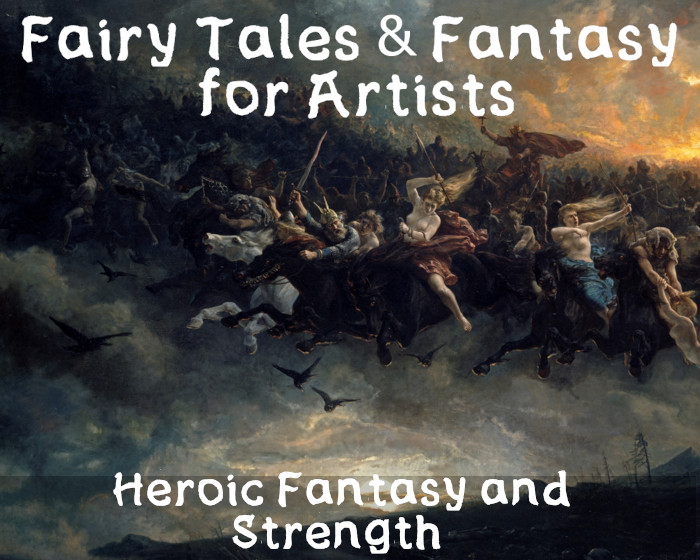Heroic Fantasy and Strength
Neoclassical art was meant to symbolize courage, patriotism, honor, human rights, freedom and the struggle for a better world. In short, the goal of Neoclassicism was not simply to represent heroes but to encourage others to become heroes. More than this, however, their simple and often stark imagery was meant to counter the decadence and frivolity displayed by the nobility of the earlier age that had brought ruin upon the European nations.
Thus the hard, angular painting “Oath of the Horatii” which depicts three brothers, asked by their father to fight for Rome in a dual against the family of Alba Longa representing the city Curiatii. One of the Horatii brothers is married to the sister of the men they are being asked to kill and their sister is engaged to one of these brothers. Yet, the Horatii brothers are depicted with angular strength, showing their willingness to sacrifice their lives and their own happiness for the good of the Republic. This is key to this painting, for it was created on the eve of the French Revolution. It became an allegory for the willingness to give one’s strength and even to sacrifice oneself for democracy and a better, freer world.
Neoclassical artists used mythology and history to try to depict social morality. According to Silvestra Bietoletti ““Neoclassical art was the aesthetic expression of the eighteenth-century philosophical movement founded on the principle of freedom of thought” which had the goal of insuring that every individual’s intellect was used to create a better world.
Having rejected frivolity and selfishness the Neoclassical artists sought to depict grandeur, heroism, and great people in hopes of shining a light for humanity, of creating a more moralistic society that is dedicated to the ideals of freedom and a hope for a better tomorrow. In large part by reminding us of our past.
Victoria Charles says “Neoclassicism reflected the intellectual, social and political changes of that period. The advent of revolutionary movements in France and America, based on classical ideals such as the democracy of ancient Athens and Rome, made Neoclassical art even more appealing. As three quarters of the French were illiterate, it created an opportunity for art to become a political tool to arouse revolutionary fervor.”
Neoclassism represents the desire for heroism to restore and build a better world in art, a longing which is reflected in the modern day painting on the cover of the book of the “Midgard Campaign Setting” a table-top RPG world by Kobold Press. Consider the opening lines of the book introducing this world.
“The age of heroes is dead, and the bridge to glory is broken— Bifrost fell long ago. The world is lost in an age of war, of dark wilderness and lost empires sunk beneath the waves. Only magic and the warmth of hope keeps lights aglow when dread things prowl and the priestly wardings shake, bent by hideous demonic rage. In this dark time, new heroes must arise to claim the crowns of Midgard, and restore the jewels to her scattered thrones. New heroes must lead a return to glory!” Midgard Campaign Setting by Wolfgang Baur
The cover art of the “Midgard Campaign Setting” by Aaron Miller shows a knight riding out of bright sun-soaked lands and into a dark forest. What light the sun provided behind him now just adds a glimmering sense of eeriness to the woods that grow darker before him. Death rides beside this knight mocking him with an hourglass, with the limits of his own mortality, and the short time he has left to accomplish what needs to be done. Yet, even with the death, the black dog, and a devil all around him the man’s face is stalwart, almost emotionless. He is represented with angular lines and posture, making him seem all the more unyielding in the face of the awesome and dreadful responsibility he faces.
What is indicated through the knight’s stoicism and the way the shadows fall on deaths face making it seem as though he is grinning wildly, is that Midgard is a world where death celebrates and the heroes move forward, dutybound to make the world a better place.
As with all great art this reflects our own world and our own time to an extent. We still desire strong and competent heroes and the book this art represents gives us an opportunity to roleplay those. More than that, however, this stoic warrior is perhaps the hero we need. They are not the angry firebrand, rather they are the stalwart rock who quietly accomplishes the things that need to be done no matter the obstacles.
This stoicism isn’t an accident, for the other paintings in the book are mostly of individual characters or sweeping actions. It is as if the art director through this choice is inviting us into dark lands where death mocks us. We stoically ride forth, yet once within we are swept up in the many moments of our character’s lives. As our character’s work to become the new heroes that “must lead a return to glory!”
















0 comments:
Post a Comment